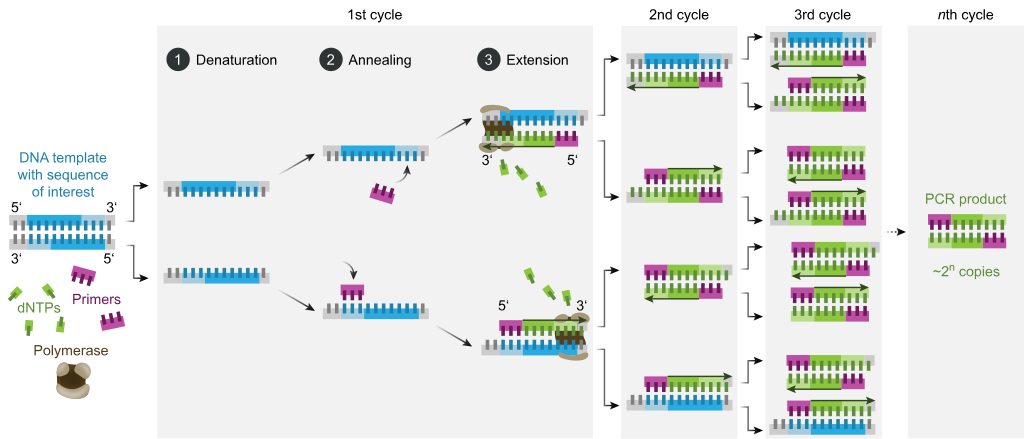
Top three applications of Polymerase Chain Reaction (PCR)
Polymerase Chain Reaction (PCR) is a laboratory technique that rapidly amplifies tiny amounts of biological samples to millions or even billions of copies of a targeted nucleotide sequence. The entire process of PCR is automated by a machine called a thermocycler which is programmed to alter the temperature of the reaction every few minutes to allow DNA denaturing, synthesis, and extension. PCR has dramatically transformed the field of medical science and molecular biology. This article summarizes the applications of PCR in different fields.
1. Genetic research:
– Since PCR needs a tiny amount of sample to amplify the DNA strands of interest, both southern and northern blot hybridization is possible for genetic analysis.
– qPCR has made the quantitative investigation of the expression level of a specific gene in different stages easier (1).
– DNA sequences can be easily amplified for DNA sequencing to study genetic mutations and chromosomal analysis to detect diseases and early birth defects.
2. Medicine:
– PCR allows crucial observations for early microorganism detection which directly impacts public health monitoring. For example, Mycobacterium tuberculosis causes Tuberculosis (TB), an important public health problem worldwide. The rapid detection of M. tuberculosis directly from clinical samples effectively reduces transmission between patients (2).
– During the COVID-19 pandemic, PCR tests used primers matching a virus’s genetic material segment. A positive COVID-19 PCR test means that SARS-CoV-2 is present (3). This allowed early detection of the virus reducing transmission, infection, and severe symptoms.
– PCR is also used to detect HIV infection early, even before the antibodies are formed.
3. Forensic science:
– PCR-based DNA fingerprinting has become an invaluable tool in forensic investigations. DNA fragments isolated from crime scenes are compared to the existing databases of convicts or criminals to rule out suspects (4).
– It is also used for genetic profiling to conduct a paternity test. Through a PCR test, it is possible to exclude paternity with a 99.9% accuracy.
References
1. Forero DA, González-Giraldo Y, Castro-Vega LJ, Barreto GE. qPCR-based methods for expression analysis of miRNAs. Biotechniques. 2019 Oct;67(4):192-199. doi: 10.2144/btn-2019-0065. Epub 2019 Sep 6. PMID: 31560239.
2. Rozales FP, Machado AB, De Paris F, Zavascki AP, Barth AL. PCR to detect Mycobacterium tuberculosis in respiratory tract samples: evaluation of clinical data. Epidemiol Infect. 2014 Jul;142(7):1517-23. doi: 10.1017/S0950268813002598. Epub 2013 Oct 10. PMID: 24107314; PMCID: PMC9151241.
3. Udugama B, Kadhiresan P, Kozlowski HN, Malekjahani A, Osborne M, Li VYC, Chen H, Mubareka S, Gubbay JB, Chan WCW. Diagnosing COVID-19: The Disease and Tools for Detection. ACS Nano. 2020 Apr 28;14(4):3822-3835. doi: 10.1021/acsnano.0c02624. Epub 2020 Mar 30. PMID: 32223179; PMCID: PMC7144809.
4. Roewer L. DNA fingerprinting in forensics: past, present, future. Investig Genet. 2013 Nov 18;4(1):22. doi: 10.1186/2041-2223-4-22. PMID: 24245688; PMCID: PMC3831584.
5. Rerkamnuaychoke B, Chantratita W, Jomsawat U, Thanakitgosate J, Rojanasunan P. Paternity testing by PCR-based STR analysis. J Med Assoc Thai. 2000 Mar;83 Suppl 1:S55-62. PMID: 10865408.



